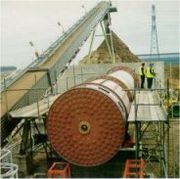Difference between revisions of "Sludge Dryers"
Jump to navigation
Jump to search
| Line 5: | Line 5: | ||
* Please start editing this page after the /noinclude | * Please start editing this page after the /noinclude | ||
* -------------------------------------------------></noinclude> | * -------------------------------------------------></noinclude> | ||
[[File: | [[File:Sludge_Dryers.jpg|thumb|200Px|right|Sludge Dryers]] | ||
The '''Sludge Dryers''' are becoming popular in order to provide greater disposal opportunities. It is used for handling sludges for both the industrial and municipal sectors. The heart of it's drying system is a Steam Tube Rotary Dryer and blender to convert the material into stable dust-free granules. The low exhaust volume helps to achieve legislative standards for emission levels. | The '''Sludge Dryers''' are becoming popular in order to provide greater disposal opportunities. It is used for handling sludges for both the industrial and municipal sectors. The heart of it's drying system is a Steam Tube Rotary Dryer and blender to convert the material into stable dust-free granules. The low exhaust volume helps to achieve legislative standards for emission levels. | ||
==='''Advantages'''=== | ==='''Advantages'''=== | ||
Revision as of 06:55, 27 July 2012
The Sludge Dryers are becoming popular in order to provide greater disposal opportunities. It is used for handling sludges for both the industrial and municipal sectors. The heart of it's drying system is a Steam Tube Rotary Dryer and blender to convert the material into stable dust-free granules. The low exhaust volume helps to achieve legislative standards for emission levels.
Advantages
- Contact drying producing dry granular product
- Large heat transfer area
- No critical sticky phase
- Low drive power
- Enclosed drying system
- Low product attrition
- Low air flow
- Minimum fines generated
- Energy efficient
